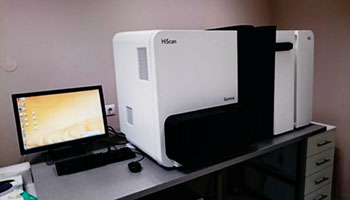Molecular Type 2 Diabetes Biomarker Identified
|
By LabMedica International staff writers Posted on 23 Feb 2016 |
Type 2 diabetes mellitus (DM) is an established risk factor for a wide range of vascular diseases, including ischemic stroke (IS) as well as heart attacks, neuropathy and blindness.
Type 2 diabetes is a chronic illness characterized by the presence of elevated blood glucose levels and it accounts for between 80% and 90% of diabetes cases and is one of the major cardiovascular risk factors.
Scientists at the Hospital del Mar Medical Research Institute (Barcelona, Spain) investigated DNA methylation in the blood samples of a cohort of 355 stroke patients using a state-of-the-art technique that allows them to study more than 450,000 methylation points in the genome. In addition, the study compared the methylation profiles of diabetics and non-diabetics as well as their levels of glycosylated hemoglobin (HbA1c), a biomarker that indicates blood glucose levels over the past three months.
DNA samples were extracted from whole peripheral blood collected in 10 mL EDTA tubes. The Chemagic Magnetic Separation Module I system (Chemagen, Baesweiler, Germany) was used for DNA isolation in one cohort, and the Autopure LS (Qiagen, Hilden, Germany) in another. Genome-wide DNA methylation was assessed using the Illumina HumanMethylation450 Beadchip (Illumina Netherlands; Eindhoven, Netherlands) and the arrays were scanned with the Illumina HiScan SQ scanner.
The study was subsequently replicated in two cohorts from independent populations, with 167 and 645 patients respectively, confirming the relationship between Thioredoxin Interacting Protein (TXNIP) methylation, diabetes and glucose level dysfunction. Methylation of TXNIP was inversely and intensely associated with HbA1c levels specifically related to diabetic patients with poor control of glucose levels. The authors concluded that hypomethylation of the TXNIP gene is related to type 2 DM. The inverse relationship between TXNIP methylation and HbA1c values suggests that TXNIP hypomethylation is a consequence of sustained hyperglycemia levels.
Carolina Soriano-Tárraga, PhD, the lead author of the study said, “The methylation of this gene could be used as an early biomarker of dysfunction in the control of glucose levels. We are currently studying the implications and specific role of this gene in diabetes. In the future it could provide a possible therapeutic target for treating diabetes or controlling glucose concentrations.” The study was published originally online on December 7, 2015, in the journal Human Molecular Genetics.
Related Links:
Hospital del Mar Medical Research Institute
Chemagen
Illumina Netherlands
Type 2 diabetes is a chronic illness characterized by the presence of elevated blood glucose levels and it accounts for between 80% and 90% of diabetes cases and is one of the major cardiovascular risk factors.
Scientists at the Hospital del Mar Medical Research Institute (Barcelona, Spain) investigated DNA methylation in the blood samples of a cohort of 355 stroke patients using a state-of-the-art technique that allows them to study more than 450,000 methylation points in the genome. In addition, the study compared the methylation profiles of diabetics and non-diabetics as well as their levels of glycosylated hemoglobin (HbA1c), a biomarker that indicates blood glucose levels over the past three months.
DNA samples were extracted from whole peripheral blood collected in 10 mL EDTA tubes. The Chemagic Magnetic Separation Module I system (Chemagen, Baesweiler, Germany) was used for DNA isolation in one cohort, and the Autopure LS (Qiagen, Hilden, Germany) in another. Genome-wide DNA methylation was assessed using the Illumina HumanMethylation450 Beadchip (Illumina Netherlands; Eindhoven, Netherlands) and the arrays were scanned with the Illumina HiScan SQ scanner.
The study was subsequently replicated in two cohorts from independent populations, with 167 and 645 patients respectively, confirming the relationship between Thioredoxin Interacting Protein (TXNIP) methylation, diabetes and glucose level dysfunction. Methylation of TXNIP was inversely and intensely associated with HbA1c levels specifically related to diabetic patients with poor control of glucose levels. The authors concluded that hypomethylation of the TXNIP gene is related to type 2 DM. The inverse relationship between TXNIP methylation and HbA1c values suggests that TXNIP hypomethylation is a consequence of sustained hyperglycemia levels.
Carolina Soriano-Tárraga, PhD, the lead author of the study said, “The methylation of this gene could be used as an early biomarker of dysfunction in the control of glucose levels. We are currently studying the implications and specific role of this gene in diabetes. In the future it could provide a possible therapeutic target for treating diabetes or controlling glucose concentrations.” The study was published originally online on December 7, 2015, in the journal Human Molecular Genetics.
Related Links:
Hospital del Mar Medical Research Institute
Chemagen
Illumina Netherlands
Read the full article by registering today, it's FREE! 

Register now for FREE to LabMedica.com and get complete access to news and events that shape the world of Clinical Laboratory Medicine. 
- Free digital version edition of LabMedica International sent by email on regular basis
- Free print version of LabMedica International magazine (available only outside USA and Canada).
- Free and unlimited access to back issues of LabMedica International in digital format
- Free LabMedica International Newsletter sent every week containing the latest news
- Free breaking news sent via email
- Free access to Events Calendar
- Free access to LinkXpress new product services
- REGISTRATION IS FREE AND EASY!
Sign in: Registered website members
Sign in: Registered magazine subscribers
Latest Molecular Diagnostics News
- Blood Test Could Identify Patients at Risk for Severe Scleroderma
- Gene-Based Blood Test Accurately Predicts Tumor Recurrence of Advanced Skin Cancer
- Rapid Blood Test Identifies Pre-Symptomatic Patients with Parkinson’s Disease
- Blood Test for Early Alzheimer's Detection Achieves Over 90% Accuracy
- RNA-Based Blood Test Detects Preeclampsia Risk Months Before Symptoms
- First Of Its Kind Test Uses microRNAs to Predict Toxicity from Cancer Therapy
- Novel Cell-Based Assay Provides Sensitive and Specific Autoantibody Detection in Demyelination
- Novel Point-of-Care Technology Delivers Accurate HIV Results in Minutes
- Blood Test Rules Out Future Dementia Risk
- D-Dimer Testing Can Identify Patients at Higher Risk of Pulmonary Embolism
- New Biomarkers to Improve Early Detection and Monitoring of Kidney Injury
- Chemiluminescence Immunoassays Support Diagnosis of Alzheimer’s Disease
- Blood Test Identifies Multiple Biomarkers for Rapid Diagnosis of Spinal Cord Injury
- Highly Accurate Blood Test Diagnoses Alzheimer’s and Measures Dementia Progression
- Simple DNA PCR-Based Lab Test to Enable Personalized Treatment of Bacterial Vaginosis
- Rapid Diagnostic Test to Halt Mother-To-Child Hepatitis B Transmission
Channels
Clinical Chemistry
view channel
New Method Uses Pulsed Infrared Light to Find Cancer's 'Fingerprints' In Blood Plasma
Cancer diagnoses have traditionally relied on invasive or time-consuming procedures like tissue biopsies. Now, new research published in ACS Central Science introduces a method that utilizes pulsed infrared... Read more
Carbon Nanotubes Help Build Highly Accurate Sensors for Continuous Health Monitoring
Current sensors can measure various health indicators, such as blood glucose levels, in the body. However, there is a need to develop more accurate and sensitive sensor materials that can detect lower... Read moreHematology
view channel
New Scoring System Predicts Risk of Developing Cancer from Common Blood Disorder
Clonal cytopenia of undetermined significance (CCUS) is a blood disorder commonly found in older adults, characterized by mutations in blood cells and a low blood count, but without any obvious cause or... Read more
Non-Invasive Prenatal Test for Fetal RhD Status Demonstrates 100% Accuracy
In the United States, approximately 15% of pregnant individuals are RhD-negative. However, in about 40% of these cases, the fetus is also RhD-negative, making the administration of RhoGAM unnecessary.... Read moreImmunology
view channel
Stem Cell Test Predicts Treatment Outcome for Patients with Platinum-Resistant Ovarian Cancer
Epithelial ovarian cancer frequently responds to chemotherapy initially, but eventually, the tumor develops resistance to the therapy, leading to regrowth. This resistance is partially due to the activation... Read more
Machine Learning-Enabled Blood Test Predicts Immunotherapy Response in Lymphoma Patients
Chimeric antigen receptor (CAR) T-cell therapy has emerged as one of the most promising recent developments in the treatment of blood cancers. However, over half of non-Hodgkin lymphoma (NHL) patients... Read moreMicrobiology
view channel
Handheld Device Delivers Low-Cost TB Results in Less Than One Hour
Tuberculosis (TB) remains the deadliest infectious disease globally, affecting an estimated 10 million people annually. In 2021, about 4.2 million TB cases went undiagnosed or unreported, mainly due to... Read more
New AI-Based Method Improves Diagnosis of Drug-Resistant Infections
Drug-resistant infections, particularly those caused by deadly bacteria like tuberculosis and staphylococcus, are rapidly emerging as a global health emergency. These infections are more difficult to treat,... Read more
Breakthrough Diagnostic Technology Identifies Bacterial Infections with Almost 100% Accuracy within Three Hours
Rapid and precise identification of pathogenic microbes in patient samples is essential for the effective treatment of acute infectious diseases, such as sepsis. The fluorescence in situ hybridization... Read morePathology
view channel
New Error-Corrected Method to Help Detect Cancer from Blood Samples Alone
"Liquid biopsy" technology, which relies on blood tests for early cancer detection and monitoring cancer burden in patients, has the potential to transform cancer care. However, detecting the mutational... Read more
"Metal Detector" Algorithm Hunts Down Vulnerable Tumors
Scientists have developed an algorithm capable of functioning as a "metal detector" to identify vulnerable tumors, marking a significant advancement in personalized cancer treatment. This breakthrough... Read more
Novel Technique Uses ‘Sugar’ Signatures to Identify and Classify Pancreatic Cancer Cell Subtypes
Pancreatic cancer is often asymptomatic in its early stages, making it difficult to detect until it has progressed. Consequently, only 15% of pancreatic cancers are diagnosed early enough to allow for... Read moreTechnology
view channel
Pain-On-A-Chip Microfluidic Device Determines Types of Chronic Pain from Blood Samples
Chronic pain is a widespread condition that remains difficult to manage, and existing clinical methods for its treatment rely largely on self-reporting, which can be subjective and especially problematic... Read more
Innovative, Label-Free Ratiometric Fluorosensor Enables More Sensitive Viral RNA Detection
Viruses present a major global health risk, as demonstrated by recent pandemics, making early detection and identification essential for preventing new outbreaks. While traditional detection methods are... Read moreIndustry
view channel
Cepheid and Oxford Nanopore Technologies Partner on Advancing Automated Sequencing-Based Solutions
Cepheid (Sunnyvale, CA, USA), a leading molecular diagnostics company, and Oxford Nanopore Technologies (Oxford, UK), the company behind a new generation of sequencing-based molecular analysis technologies,... Read more
Grifols and Tecan’s IBL Collaborate on Advanced Biomarker Panels
Grifols (Barcelona, Spain), one of the world’s leading producers of plasma-derived medicines and innovative diagnostic solutions, is expanding its offer in clinical diagnostics through a strategic partnership... Read more
























